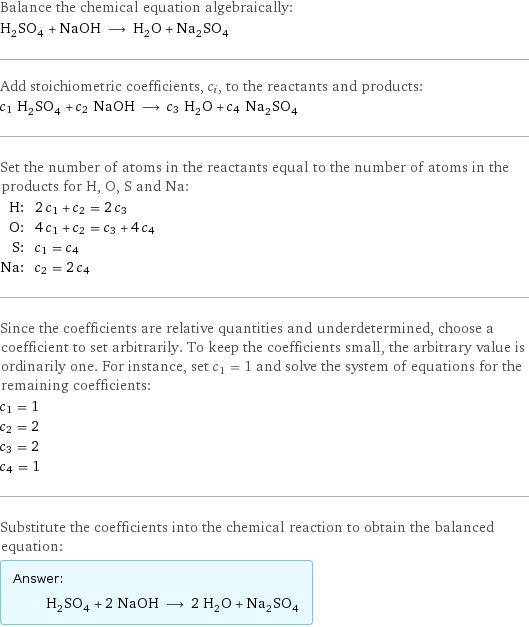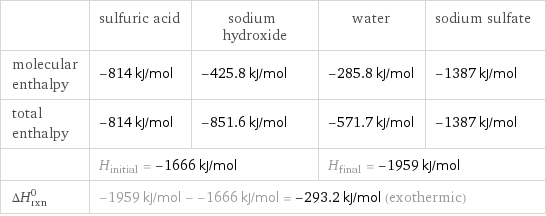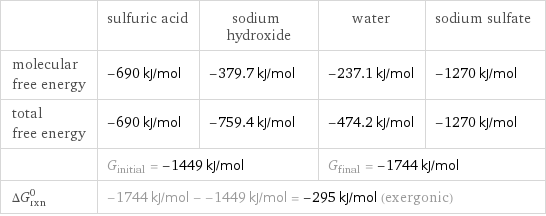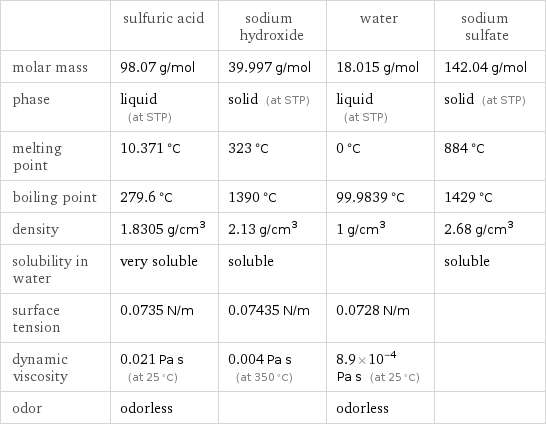Input interpretation

H_2SO_4 sulfuric acid + NaOH sodium hydroxide ⟶ H_2O water + Na_2SO_4 sodium sulfate
Balanced equation

Balance the chemical equation algebraically: H_2SO_4 + NaOH ⟶ H_2O + Na_2SO_4 Add stoichiometric coefficients, c_i, to the reactants and products: c_1 H_2SO_4 + c_2 NaOH ⟶ c_3 H_2O + c_4 Na_2SO_4 Set the number of atoms in the reactants equal to the number of atoms in the products for H, O, S and Na: H: | 2 c_1 + c_2 = 2 c_3 O: | 4 c_1 + c_2 = c_3 + 4 c_4 S: | c_1 = c_4 Na: | c_2 = 2 c_4 Since the coefficients are relative quantities and underdetermined, choose a coefficient to set arbitrarily. To keep the coefficients small, the arbitrary value is ordinarily one. For instance, set c_1 = 1 and solve the system of equations for the remaining coefficients: c_1 = 1 c_2 = 2 c_3 = 2 c_4 = 1 Substitute the coefficients into the chemical reaction to obtain the balanced equation: Answer: | | H_2SO_4 + 2 NaOH ⟶ 2 H_2O + Na_2SO_4
Structures

+ ⟶ +
Names

sulfuric acid + sodium hydroxide ⟶ water + sodium sulfate
Reaction thermodynamics
Enthalpy

| sulfuric acid | sodium hydroxide | water | sodium sulfate molecular enthalpy | -814 kJ/mol | -425.8 kJ/mol | -285.8 kJ/mol | -1387 kJ/mol total enthalpy | -814 kJ/mol | -851.6 kJ/mol | -571.7 kJ/mol | -1387 kJ/mol | H_initial = -1666 kJ/mol | | H_final = -1959 kJ/mol | ΔH_rxn^0 | -1959 kJ/mol - -1666 kJ/mol = -293.2 kJ/mol (exothermic) | | |
Gibbs free energy

| sulfuric acid | sodium hydroxide | water | sodium sulfate molecular free energy | -690 kJ/mol | -379.7 kJ/mol | -237.1 kJ/mol | -1270 kJ/mol total free energy | -690 kJ/mol | -759.4 kJ/mol | -474.2 kJ/mol | -1270 kJ/mol | G_initial = -1449 kJ/mol | | G_final = -1744 kJ/mol | ΔG_rxn^0 | -1744 kJ/mol - -1449 kJ/mol = -295 kJ/mol (exergonic) | | |
Equilibrium constant
![Construct the equilibrium constant, K, expression for: H_2SO_4 + NaOH ⟶ H_2O + Na_2SO_4 Plan: • Balance the chemical equation. • Determine the stoichiometric numbers. • Assemble the activity expression for each chemical species. • Use the activity expressions to build the equilibrium constant expression. Write the balanced chemical equation: H_2SO_4 + 2 NaOH ⟶ 2 H_2O + Na_2SO_4 Assign stoichiometric numbers, ν_i, using the stoichiometric coefficients, c_i, from the balanced chemical equation in the following manner: ν_i = -c_i for reactants and ν_i = c_i for products: chemical species | c_i | ν_i H_2SO_4 | 1 | -1 NaOH | 2 | -2 H_2O | 2 | 2 Na_2SO_4 | 1 | 1 Assemble the activity expressions accounting for the state of matter and ν_i: chemical species | c_i | ν_i | activity expression H_2SO_4 | 1 | -1 | ([H2SO4])^(-1) NaOH | 2 | -2 | ([NaOH])^(-2) H_2O | 2 | 2 | ([H2O])^2 Na_2SO_4 | 1 | 1 | [Na2SO4] The equilibrium constant symbol in the concentration basis is: K_c Mulitply the activity expressions to arrive at the K_c expression: Answer: | | K_c = ([H2SO4])^(-1) ([NaOH])^(-2) ([H2O])^2 [Na2SO4] = (([H2O])^2 [Na2SO4])/([H2SO4] ([NaOH])^2)](../image_source/57db8bc9b3951e01d5a5e550dcdd41e4.png)
Construct the equilibrium constant, K, expression for: H_2SO_4 + NaOH ⟶ H_2O + Na_2SO_4 Plan: • Balance the chemical equation. • Determine the stoichiometric numbers. • Assemble the activity expression for each chemical species. • Use the activity expressions to build the equilibrium constant expression. Write the balanced chemical equation: H_2SO_4 + 2 NaOH ⟶ 2 H_2O + Na_2SO_4 Assign stoichiometric numbers, ν_i, using the stoichiometric coefficients, c_i, from the balanced chemical equation in the following manner: ν_i = -c_i for reactants and ν_i = c_i for products: chemical species | c_i | ν_i H_2SO_4 | 1 | -1 NaOH | 2 | -2 H_2O | 2 | 2 Na_2SO_4 | 1 | 1 Assemble the activity expressions accounting for the state of matter and ν_i: chemical species | c_i | ν_i | activity expression H_2SO_4 | 1 | -1 | ([H2SO4])^(-1) NaOH | 2 | -2 | ([NaOH])^(-2) H_2O | 2 | 2 | ([H2O])^2 Na_2SO_4 | 1 | 1 | [Na2SO4] The equilibrium constant symbol in the concentration basis is: K_c Mulitply the activity expressions to arrive at the K_c expression: Answer: | | K_c = ([H2SO4])^(-1) ([NaOH])^(-2) ([H2O])^2 [Na2SO4] = (([H2O])^2 [Na2SO4])/([H2SO4] ([NaOH])^2)
Rate of reaction
![Construct the rate of reaction expression for: H_2SO_4 + NaOH ⟶ H_2O + Na_2SO_4 Plan: • Balance the chemical equation. • Determine the stoichiometric numbers. • Assemble the rate term for each chemical species. • Write the rate of reaction expression. Write the balanced chemical equation: H_2SO_4 + 2 NaOH ⟶ 2 H_2O + Na_2SO_4 Assign stoichiometric numbers, ν_i, using the stoichiometric coefficients, c_i, from the balanced chemical equation in the following manner: ν_i = -c_i for reactants and ν_i = c_i for products: chemical species | c_i | ν_i H_2SO_4 | 1 | -1 NaOH | 2 | -2 H_2O | 2 | 2 Na_2SO_4 | 1 | 1 The rate term for each chemical species, B_i, is 1/ν_i(Δ[B_i])/(Δt) where [B_i] is the amount concentration and t is time: chemical species | c_i | ν_i | rate term H_2SO_4 | 1 | -1 | -(Δ[H2SO4])/(Δt) NaOH | 2 | -2 | -1/2 (Δ[NaOH])/(Δt) H_2O | 2 | 2 | 1/2 (Δ[H2O])/(Δt) Na_2SO_4 | 1 | 1 | (Δ[Na2SO4])/(Δt) (for infinitesimal rate of change, replace Δ with d) Set the rate terms equal to each other to arrive at the rate expression: Answer: | | rate = -(Δ[H2SO4])/(Δt) = -1/2 (Δ[NaOH])/(Δt) = 1/2 (Δ[H2O])/(Δt) = (Δ[Na2SO4])/(Δt) (assuming constant volume and no accumulation of intermediates or side products)](../image_source/7d56999ba95b110a5eb84d5451cda0df.png)
Construct the rate of reaction expression for: H_2SO_4 + NaOH ⟶ H_2O + Na_2SO_4 Plan: • Balance the chemical equation. • Determine the stoichiometric numbers. • Assemble the rate term for each chemical species. • Write the rate of reaction expression. Write the balanced chemical equation: H_2SO_4 + 2 NaOH ⟶ 2 H_2O + Na_2SO_4 Assign stoichiometric numbers, ν_i, using the stoichiometric coefficients, c_i, from the balanced chemical equation in the following manner: ν_i = -c_i for reactants and ν_i = c_i for products: chemical species | c_i | ν_i H_2SO_4 | 1 | -1 NaOH | 2 | -2 H_2O | 2 | 2 Na_2SO_4 | 1 | 1 The rate term for each chemical species, B_i, is 1/ν_i(Δ[B_i])/(Δt) where [B_i] is the amount concentration and t is time: chemical species | c_i | ν_i | rate term H_2SO_4 | 1 | -1 | -(Δ[H2SO4])/(Δt) NaOH | 2 | -2 | -1/2 (Δ[NaOH])/(Δt) H_2O | 2 | 2 | 1/2 (Δ[H2O])/(Δt) Na_2SO_4 | 1 | 1 | (Δ[Na2SO4])/(Δt) (for infinitesimal rate of change, replace Δ with d) Set the rate terms equal to each other to arrive at the rate expression: Answer: | | rate = -(Δ[H2SO4])/(Δt) = -1/2 (Δ[NaOH])/(Δt) = 1/2 (Δ[H2O])/(Δt) = (Δ[Na2SO4])/(Δt) (assuming constant volume and no accumulation of intermediates or side products)
Chemical names and formulas

| sulfuric acid | sodium hydroxide | water | sodium sulfate formula | H_2SO_4 | NaOH | H_2O | Na_2SO_4 Hill formula | H_2O_4S | HNaO | H_2O | Na_2O_4S name | sulfuric acid | sodium hydroxide | water | sodium sulfate IUPAC name | sulfuric acid | sodium hydroxide | water | disodium sulfate
Substance properties

| sulfuric acid | sodium hydroxide | water | sodium sulfate molar mass | 98.07 g/mol | 39.997 g/mol | 18.015 g/mol | 142.04 g/mol phase | liquid (at STP) | solid (at STP) | liquid (at STP) | solid (at STP) melting point | 10.371 °C | 323 °C | 0 °C | 884 °C boiling point | 279.6 °C | 1390 °C | 99.9839 °C | 1429 °C density | 1.8305 g/cm^3 | 2.13 g/cm^3 | 1 g/cm^3 | 2.68 g/cm^3 solubility in water | very soluble | soluble | | soluble surface tension | 0.0735 N/m | 0.07435 N/m | 0.0728 N/m | dynamic viscosity | 0.021 Pa s (at 25 °C) | 0.004 Pa s (at 350 °C) | 8.9×10^-4 Pa s (at 25 °C) | odor | odorless | | odorless |
Units
